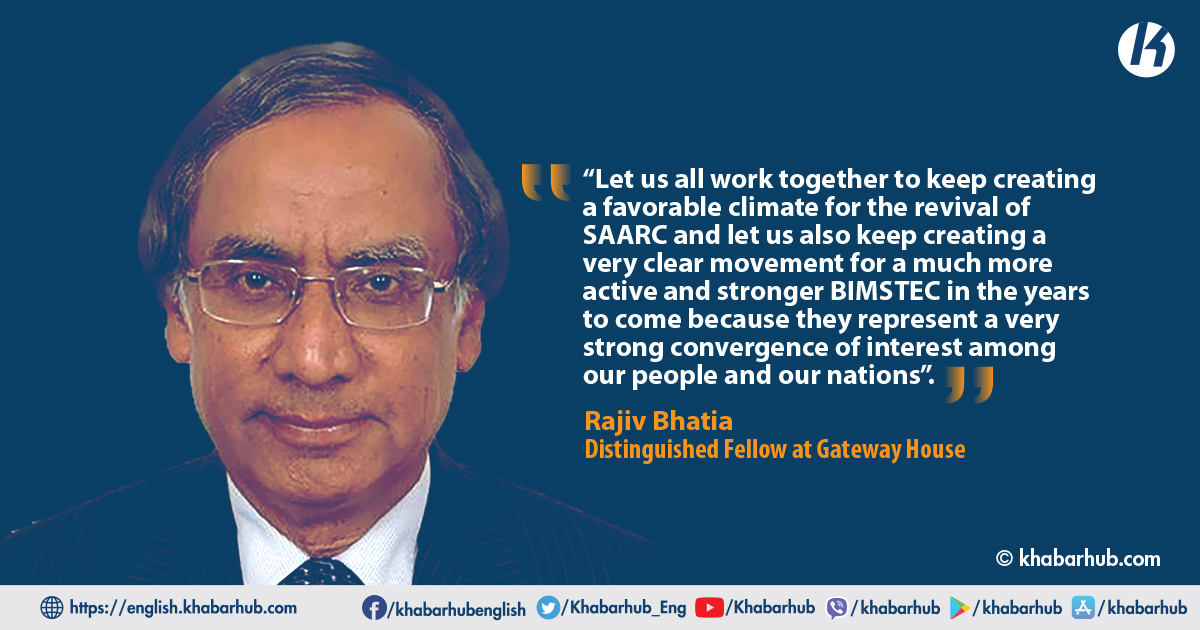Ambassador Rajiv Bhatia is a Distinguished Fellow at Gateway House. He was the Director-General of the Indian Council of World Affairs and served as Ambassador to Myanmar and Mexico and as High Commissioner to Kenya, South Africa and Lesotho.
He was a Senior Visiting Research Fellow at the Institute of Southeast Asian Studies, Singapore, and is a founding member of the Kalinga International Foundation.
He is also Chair of the Core Group of Experts on BIMSTEC and a member of the governing council of Asian Confluence. He has published ‘India in Global Affairs: Perspectives from Sapru House’ and ‘India-Myanmar Relations: Changing contours’.
Dr. Pramod Jaiswal, Strategic Affairs Editor at Khabarhub, spoke to Ambassador Rajiv Bhatia on various aspects of BIMSTEC
Is the significance of BIMSTEC growing in the Indian Foreign Policy?
I think it would be true to say that the importance of BIMSTEC, which is an association between seven countries, five from South Asia and two from South-East Asia has indeed been growing for India and for all the other member states.
I assert this mainly because BIMSTEC touches at least three key policies of India. Number one, the neighborhood first policy; number two, the Act East policy and number three the national strategy to expand and accelerate the development of the North-Eastern region of India.
So, in effect, BIMSTEC, we hope will contribute to the fulfillment of all the three policies and objectives, and therefore it is important.
But I must also add a word of caution here, if not disappointment, I think if we look at the recent history of BIMSTEC we recognize that until about 2015, BIMSTEC had only secured modest or limited progress, but between 2016 and 2019, BIMSTEC actually showed a lot of activism, a lot of progress.
The summit took place in 2018, and the follow-up was taken up in a big manner, but in the COVID-19 era, suddenly it again went back into a phase of passivity.
So, I would say, we have been very enthusiastic about the growing assertiveness of BIMSTEC, but we really want it now to overcome the touch of inertia that it has shown in the past year and a half.
As the BIMSTEC Secretariat was set up in 2014, there are talks about the FTA gaining some ground, the sectors of engagement have been narrowed to 5 more focused areas compared to the 16 originally enumerated. What should we make of these developments in the context of multilateral cooperation in the region?
I think the recent development of BIMSTEC should be appreciated in the context of developments since 2016. In 2016, India hosted the BRICS summit, the summit at that time had the tradition of arranging interaction between BRICS leaders and leaders of the neighborhood of the host countries.
So, when India was hosting the summit, India thought of inviting the leaders of BIMSTEC. Therefore, as a result, leaders of Bangladesh, Nepal, Bhutan, Sri Lanka, Myanmar, and Thailand were invited.
First, they met in retreat and then they met with the leaders of BRICS which are Russia, China, India, Brazil, and South Africa. And from that time onwards, it came into big prominence, the BIMSTEC, then I think of the suggestion of Nepal, BIMSTEC realized that it needed a formal charter.
It then started the journey on institutional reforms and a big push was given to the idea of reform at the 2018 summit. And to give credit to the diplomats and officials involved, they produced a very important and substantial package of reforms.
This package was even approved by the foreign ministers of BIMSTEC in their June 2021 meeting. So, while BIMSTEC is still not able to do very much on the economic side directly, especially on the side of the Comprehensive Trade Agreement, it has prepared the ground for very substantial institutional reforms including the prioritization of sectors, but the only difficulty today is that the BIMSTEC summit keeps getting delayed. It was supposed to be taking place in 2020 then at some stage in 2021.
Now the news from the chair, Sri Lanka is that Sri Lankans are keen on an in-person summit and that depends on the assessment of the COVID-19 situation.
So, we are hoping that an in-person summit would take place before this year is out or at least a digital summit would take place because it is far too long for an association like ours to remain in a bit of a limbo at the highest political level.
Do you think that bilateral level engagements and cooperation can translate into increased efficiency at a multilateral level? Has this proved to be effective in the context of BIMSTEC?
I agree with you completely. I think the good health of a club depends on the good state of the bilateral relations of the members.
If two or three or four sets of members are busy fighting with each other for some reason or the other, that club cannot progress really well.
Luckily that’s not the case with BIMSTEC, it may be more with SAARC but not with BIMSTEC, yet unfortunately, in the last two to three years, one has to be quite honest because we are in a scholarly setting here.
There have been tensions in India-Nepal relations, in India-Sri Lanka relations, in Bangladesh-Myanmar relations and they have had some impact on what I call the inertia of BIMSTEC.
And that is the reason why I think the intellectual leaders of these countries and the leaders of the eminent think tanks of BIMSTEC areas, have a special responsibility to try to advocate the view, this institution is needed for the benefit of the security, prosperity and progress for our region and it must meet regularly and must attend to all its duties properly.

Why is India failing to counter Chinese infrastructure projects in the region by effective utilization of BIMSTEC and SAARC? In this background, do you believe the re-emergence of BIMSTEC and SAARC can neutralize Chinese influences in South Asian countries?
Well, I think I would have some difficulties with this question with the way it is framed. It sorts of betrays the notion that India has the same economic muscle as China.
You and I know very well that the Chinese economy is about five times bigger than India’s economy, we have the same kind of population but the Chinese economy is five times bigger, therefore let alone India even advanced countries find it difficult to compete with the cheque-book diplomacy of China.
Therefore, to argue that India is failing to utilize SAARC and BIMSTEC and thereby neutralize China’s influence in South Asia is a flawed argument.
My own view would be that in the underperformance or to be very frank the non-performance of SAARC in the past several years and the slow development of BIMSTEC, there is a multiplicity of factors, which is at work.
This has something to do with, first of all, all of us, that is the countries of the region, it has also certainly something to do with SAARC, the India-Pakistan issues.
It has also something to do when we talk about both SAARC and BIMSTEC with regard to the mindset of the smaller neighbors of India.
And above all, it has much to do with the role of the external powers, particularly China at this stage. In short, South Asia, shaped by its history and geography, is a neighborhood of our own countries and neighbors and China in my view can never be treated as a member of South Asia.
But that doesn’t mean that South Asia cannot have cooperative relations with China. It certainly can and it must. Yet there has to be some basic respect for the boundaries of South Asia as we understand it so far.
Do you see the possibility of SAARC and BIMSTEC working together as there are various sectors where both can work together?
This is again a very well-founded question. It is based on rationality and sound logic. Unfortunately for reasons which are totally not clear to me, these two institutions have kind of worked in parallel.
In fact, they should work in a complementary fashion, as we know SAARC Secretariat is located in Nepal, BIMSTEC Secretariat is located in Dhaka.
So, in one of the institutions or in fact an event, I had suggested that the secretary-general of SAARC and secretary-general of BIMSTEC, should be natural interlocutors to discuss the broader and similar development challenges of this region. But I know that this perhaps doesn’t happen due to some sensitive political reasons.
But let’s hope that a day comes when both these institutions will find themselves on the path of normal functioning and if God willing that day arrives particularly with regard to SAARC, surely BIMSTEC will meet and it will function normally.
But if that day would have to come for SAARC, then this question you have raised will become relevant and it should be reflected upon with due care.
As the developments of BIMSTEC are at a snail pace, do you think BIMSTEC can also meet a similar fate as SAARC?
No, I hope not, I’m confident about the future of BIMSTEC. It has much greater convergence; it doesn’t carry the burden of India, Pakistan tensions.
It certainly is totally immune from the implications of the recent upheaval in Afghanistan and the synthesizing of interest in the member states in BIMSTEC is much more close.
I think what BIMSTEC really needs is to work seriously on the package of reforms that have already been agreed upon.
It needs to strengthen the secretariat, it needs to provide certain financial powers if not, financial autonomy to the secretariat.
It must find adequate funds for various development projects that it has in mind. BIMSTEC has already worked on a master plan for regional connectivity which is awaiting the approval of the Heads of state and government.
And above all, this rationalization of sectors has been recommended bringing down the number of sectors of cooperation from 14 to 7, with each member country being a lead country for that particular sector.
I think that needs to be implemented. So, if these aims are kept in view, we can be certain that BIMSTEC will have a reasonably bright future, but above all, if you allow me I would say that it cannot succeed only as a club of the governments.
There is a need for engaging very actively, the business communities of our member states and above all, the third phase or the people to people context among our member states, then we can be confident of a bright future for BIMSTEC.
Why did BIMSTEC emerge as a preferred grouping of countries in South Asia? It’s been more than two decades since the formation of BIMSTEC. Is it still struggling for relevance especially in the context of countries like Nepal?
This is where we come to grapple with the trajectory of SAARC and the trajectory of BIMSTEC.
Even when SAARC was functioning normally, as you know SAARC was established in 1985, even when it was functioning, India, Sri Lanka, Nepal, Bhutan, Bangladesh, Thailand and Myanmar thought it fit to have this new body because this was in consonance with the view that there is natural connectivity between parts of South Asia and parts of South East Asia.
So BIMSTEC was created and it made some progress but it was not making too much progress because there was SAARC as well.
It is only when SAARC came to a kind of stop in 2014 that was the last summit. From that point onwards, I should not conceal the fact India gave a special push to BIMSTEC and that is how it went through a very positive phase till about 2019.
Now all the parameters of convergence culturally, economically in terms of trade, in terms of transportation they are much stronger in the case of BIMSTEC and you have a very advanced economy in Thailand, a very fast-moving economy in Bangladesh and therefore slowly the idea began to come or emerge that all the seven countries in direct or indirect terms can subscribe to the concept of the Bay of Bengal community.
So that vision related to the Bay of Bengal, Nepal is definitely directly connected because without Nepal’s Himalayas and rivers, the Bay of Bengal would not be there. So the Bay of Bengal community, that identity is driving BIMSTEC forward and therefore I can reiterate that we should look forward to the next summit giving a very special push to the future trajectory of our institution.
Why did the BIMSTEC countries avoid discussing the military suppression in Myanmar despite the calls to strongly raise the issue?
This has something fundamentally to do with the inner political philosophy of BIMSTEC. It is a body for multisectoral, technical and economic cooperation among its seven-member states.
It avoids contentious political bilateral issues and it certainly respects the sovereignty of each member state which means it does not interfere in the internal affairs of the states.
So clearly, BIMSTEC doesn’t have any formal role in the case of what Myanmar is going through; political security and constitutional crisis in the country.
Now does that mean BIMSTEC has not even an informal role to help ease out the matters? No, I think we will not go to that extent, but then there is yet another problem, which is i.e due to the actions of the Myanmar government or if you wish to call the Myanmar military, millions from the state were driven to seek shelter in neighboring Bangladesh, so there is this further dark weight of Myanmar-Bangladesh tensions bearing on BIMSTEC.
It is because of these reasons, BIMSTEC political leaders, officials, diplomats are unable to contribute to any resolution for the Myanmar issue and therefore the world has agreed that if there is any regional body that can help, it is ASEAN.
And as you know very well, even ASEAN is struggling badly to deal with this issue. So, let us hope that a resolution will emerge through the efforts of others which will then help BIMSTEC to grow in a normal manner.
What agendas were finalized during the recent 17th BIMSTEC Ministerial Meetings held virtually? Do you see any progress on those agendas?
My information and research indicate that it was a good, substantial meeting held in June, all the foreign ministers were there.
I think they were enthusiastic about the work done by senior officials and experts, they agreed on a number of key elements of the agenda.
First of all, they agreed on the drafting of the new Charter for BIMSTEC, and for this, I should apportion a good chunk of credit to Nepal because the idea emerged from the Nepalese government.
So, we would soon have a brand-new substantial Charter, a kind of constitution of BIMSTEC, which it didn’t have so far.
And then, there are very clear series of reforms which have been agreed upon- financial reforms, administrative reform for the secretariat, the reduction of the number of sectors for practical cooperation and above all the master plan of connectivity.
So, all these proposals are ready and also, I think the regular summits are to be held by BIMSTEC; they are just waiting for the approval of the heads of state and the governments.
Therefore, I hope it would be agreed that the sooner our leaders meet, the better it would be for the future of BIMSTEC and its ability to contribute to the economic development, for the peace and cooperation of the region.
According to you, where does Nepal stand in the SAARC as well as the BIMSTEC narrative? What roles can Nepal play in these multilateral organizations?
Both as a friend of Nepal and as an observer, I can say with full sincerity that Nepal has a very significant role to play in both these regional organizations.
I think public intellectuals, institutions, officials, diplomats, leaders of Nepal fully understand the needs of these two institutions in our region.
South Asia is a region that hosts a massive chunk of the world population, it is a region that is heavily and very densely populated, which is still struggling to alleviate poverty and accelerate economic development, which trades much less among itself than many other regions.
It’s also a region that is afflicted with various kinds of political tensions and above all, it is the region where one of the external powers has been coming into the region in a very big manner, something that we have not seen before.
So, given all these considerations, Nepal has a prominent role to play, for the simple reason that it was and it is the founding member of both institutions, it hosts the secretariat for one of the institutions- SAARC, it is continuing to be the chair of SAARC and is a very prominent and active member of BIMSTEC.
We look forward to Nepal, a very close, traditional, steadfast friend and neighbor of India to play a fairer role. We look forward to Nepal playing the leadership role to safeguard the sanctity of South Asia.
Certainly, it has an informal role to play in terms of trying to remove the obstacles to further the growth of SAARC, of course, this is the bigger issue but on BIMSTEC, it has certainly a much easier wicket to play on.
And therefore, my request to friends in Nepal would be the same as my request to friends in India and Sri Lanka – “Let us all work together to keep creating a favorable climate for the revival of SAARC and let us also keep creating a very clear movement for a much more active and stronger BIMSTEC in the years to come because they represent a very strong convergence of interest among our people and our nations”.









Comment